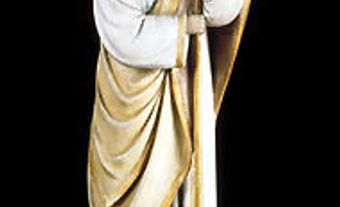
Frances Norma Loring, sculptor (born 14 October 1887 in Wardner, Idaho; died 5 February 1968 in Newmarket, ON). A member of the Royal Canadian Academy of Arts, founding member of the Sculptors Society of Canada, and one of Canada’s representatives at the 1960 Venice Biennale, Frances Loring was one of Canada’s most prominent sculptors. She was responsible for works such as the lion on the Queen Elizabeth Way Monument (1939) — originally located at the Toronto entrance to the Queen Elizabeth Way and now in the Sir Casimir Gzowski Park in Toronto — and the statue of Robert Borden (1957) on Parliament Hill in Ottawa.
Education and Early Career
Frances Loring studied at the École des Beaux-Arts in Geneva, Switzerland (1901–03), with German sculptor Carl Guttner in Munich, Germany (1903), at the Académie Colarossi in Paris, France (1904–06), at the Chicago Art Institute (1906), the School of the Museum of Fine Arts in Boston and the Art Students League in New York (1910). While at the Chicago Art Institute, Loring met her lifelong partner and collaborator, Florence Wyle.
Loring and Wyle moved to New York City’s Greenwich Village in 1909, and relocated to Toronto in 1913. The couple eventually established a studio and residence in a converted church schoolhouse in Toronto’s Moore Park neighborhood, where they lived for almost 50 years and established what was widely considered the salon of Canada's art world.
From the time she settled in Canada, Loring worked tirelessly, both in the development of her own work and in fostering a climate that made sculpture possible for others. A fascinating, compelling personality of keen intelligence and warm understanding, she assailed public and official indifference to sculpture as a founding member of the Sculptors Society of Canada and a chief organizer of the Federation of Canadian Artists and the Canada Council for the Arts.
Sculpture

Over the course of her long career, Loring worked in a variety of materials and scales. Grief (1918), for instance, is a small bronze sculpture of a woman slumped over in grief, arms loose and head hanging. Given the date of the piece, one imagines the woman has just received news that her husband or brother died in the First World War. Derelicts (1929), inspired, one assumes, by the mass poverty caused by the onset of the Great Depression in 1929, is of a woman wearing a headscarf and an old, wrinkled dress clutching her stomach, head bowed. Inuit Mother and Child (1938), on the other hand, is an elegant, life-size limestone carving of an Inuk woman in traditional clothes, carrying her baby on her back.
Public Sculpture
Loring is perhaps best known for her large-scale public monuments. Her 1928 war memorial in the Great Library in Osgoode Hall at the University of Toronto is a larger-than-life man carved from Carrara marble, a toga draped over his shoulder, his lean, muscular body otherwise naked. With his arms at his sides, palms turned out, and his head tilted back, gazing toward the sky, the figure, modelled on classical Greek sculpture, is by turns humble and serene. For the Queen Elizabeth Way Monument (originally located at the Toronto entrance to the Queen Elizabeth Way and moved to the Casimir Gzowski Park on the shore of Lake Ontario when the highway was widened in 1975), Loring, in collaboration with Wyle, carved the crown at the top of the monument, a medallion with profiles of King George VI and Queen Elizabeth, and a regal lion at the base. Loring’s bronze statue of former Canadian Prime Minister Robert Borden, on the other hand, is a relatively traditional portrait of a politician: donning a suit and tie and an overcoat, Borden stands firmly clutching a rolled up piece of paper, perhaps a document announcing Canada’s participation in the First World War, his face grave and determined.
Both Frances Loring and Florence Wyle died in 1968, and both included provisions in their wills for the proceeds of the sale of their work to be donated to a fund set up to purchase the work of young sculptors and have the work exhibited in public galleries across Canada. The fund has had a significant impact on sculpture in Canada.

 Share on Facebook
Share on Facebook Share on X
Share on X Share by Email
Share by Email Share on Google Classroom
Share on Google Classroom

